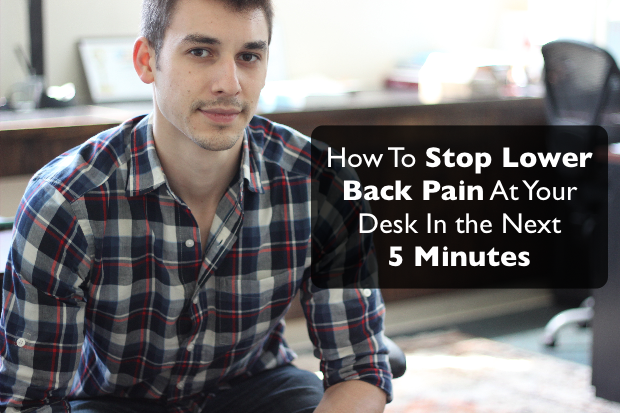
Use The “Towel Technique” To Get Quick Lower Back Pain Relief At Your Desk

Is back pain at your desk pretty much unavoidable?
I’m at a desk a LOT. And for many years, lower back pain was pretty much unavoidable.
Since I’ve gotten rid of my own chronic pain (2 years and counting!), I’ve also helped lots of people do the same. And sometimes I get a frustrated person who took my advice on fixing back pain (which worked), but then it came back as soon as they started sitting again.
So in other words, they were just creating the conditions all over again for back pain – and most often that’s what you’re doing (or not doing) at your desk.
There’s one thing you can do right now that will dramatically, quickly reduce back (and neck, and shoulder) pain.
Not a standing desk.
Not foam rolling.
Not even hot spots or trigger points.
Here’s what it is:
Even if your upper back or neck/shoulders hurt, just focus on the lower back, and use “the towel technique.”
How Your Lower Back Should NOT Be
So for starters… it’s usually pretty obvious how your back should not be.
The spine is designed to have a nice “S” curve – this is how it loads weight properly, and can compress on your disks evenly.
But here’s how many of us sit throughout the day:
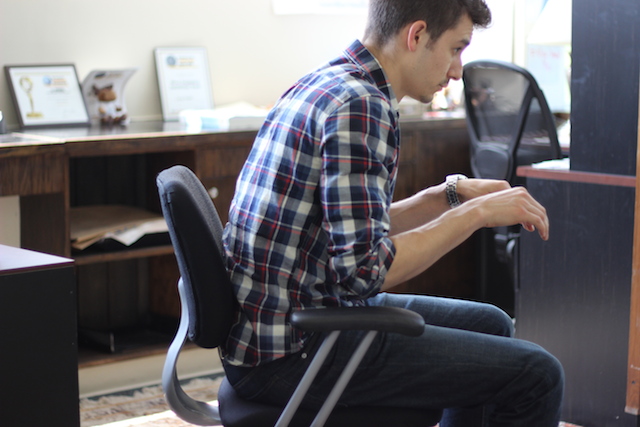
Here are some of the problems with this.
The first is that the lower back is missing the proper curve:
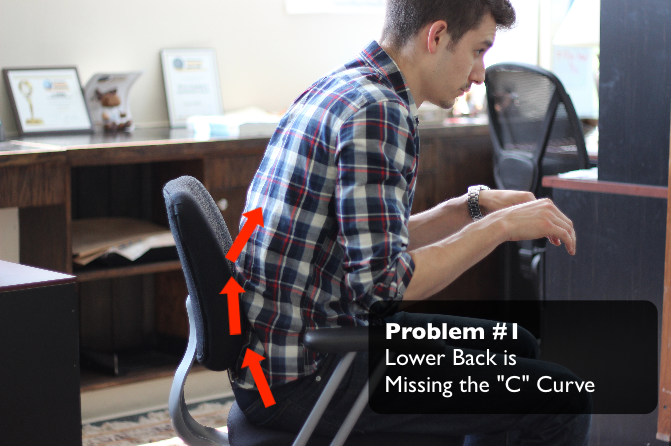
The second is that the upper back, which is supposed to be straight, is now hunched over and C-shaped too. This affects your shoulder, your neck, and even repetitive stress injuries like carpal tunnel since the body is being overused in a way it wasn’t designed to be use.

The third problem is that the shoulders aren’t aligned – they should be aligned with your ear, and your hip. So there should be a pretty much straight line in between all of these:
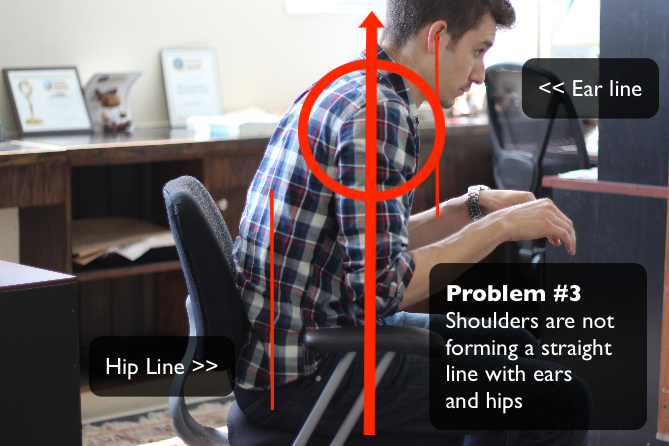
And the fourth problem is that the neck and head are not sitting on top of the body, just casually hanging out there. The neck is angled at 45 degrees, which is hell for your neck because now you’re trying to use your 10 pound head (weight) to fight against gravity. Neck pain anyone?
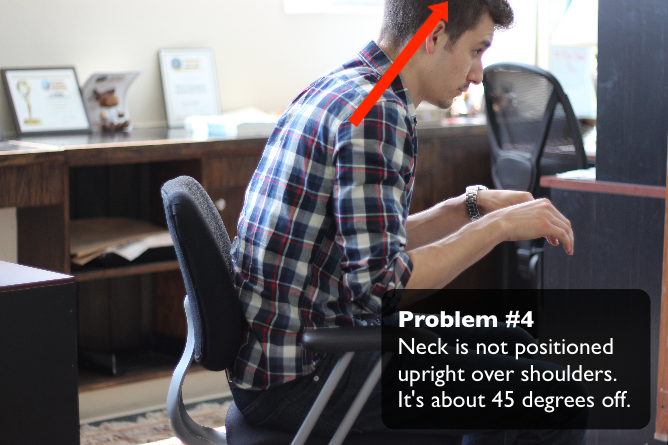
How Your Lower Back SHOULD Be
So let’s keep it short and sweet: the towel technique is an extremely easy, quick fix to these problems.
Here’s what you do: Just take a towel, a shirt, a sweater, or anything that can add about 3 inches of thickness, and then place it behind your lower back.
That’s it.
Even if you have upper back pain.
Even if you have neck pain.
Even if you have shoulder pain.
Let’s talk about what it fixes:
First, it restores the lower back curve. Almost everything just follows the lower back. So once that’s fixed, the upper back follows suit. The lower back curve is critical because it ensures weight is loading on your spinal discs properly.
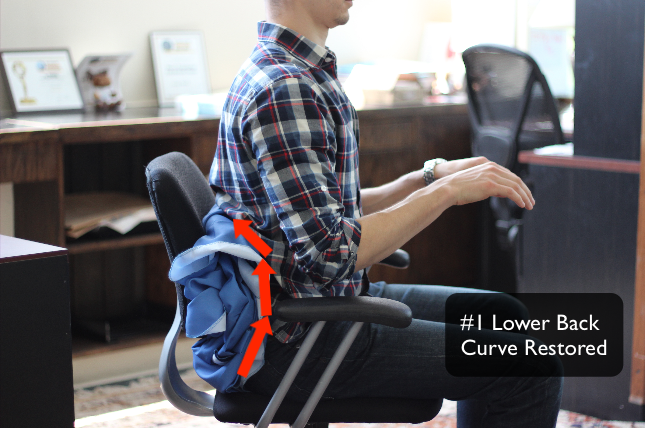
Second, this restores the upper back. Many of you have this frustrating burning between the shoulder blades. Or shoulder pain. Or carpal tunnel. These are all related to the upper back alignment. Once that is restored (by fixing the lower back!) this kind of stuff goes away on its own.
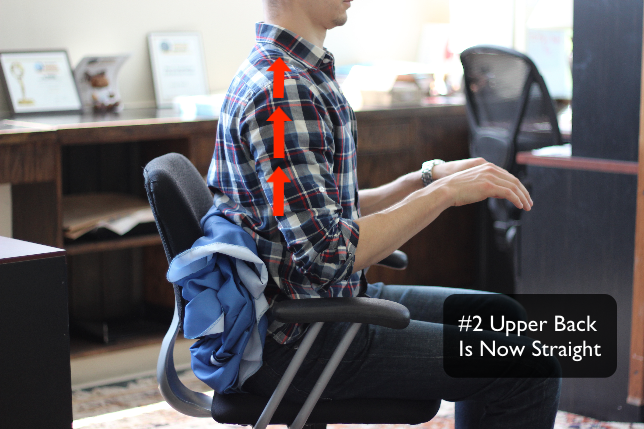
Third, the shoulders become properly aligned. Remember, they should roughly align with the hip, and with the ear. When you’re hunched over, they are way too far forward, and guess what? The neck follows suit. Everything is connected – so once the lower back is messed up, most things follow. Now, the shoulder is aligned.
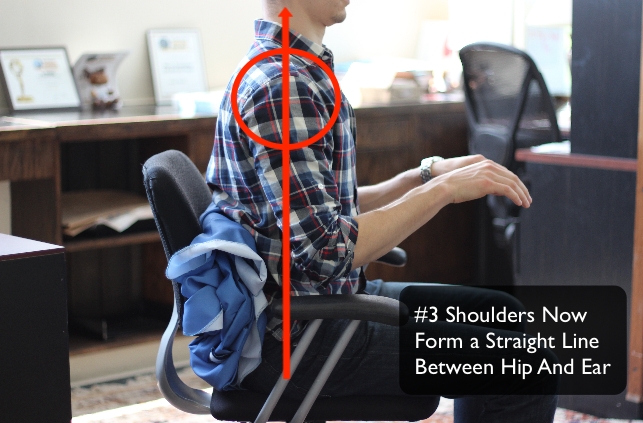
Fourth, the neck is finally upright. Now, that 10 pound weight known as your head is no longer fighting gravity, but is comfortably resting on top of your skeleton.
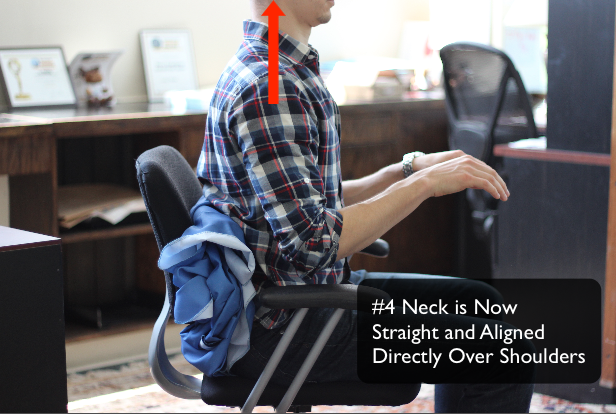
Voila – there you go. The towel technique.
Extremely easy to do at work.
Takes 30 seconds.
Produces measurable pain relief.
Coming Soon: The Back Pain Freedom Program
The above pictures are stills from videos in a brand new program I’ve been filming.
Next month I’m opening very limited registration for a new program that has been way overdue: Back Pain Freedom.
The program is shot in gorgeous full HD video and is the A-Z for getting quick, permanent back, neck and shoulder pain relief for desk workers. It’s the exact system I used to permanently end my 5 year battle with chronic pain.
It’s going to be a one-stop shop for those of you with lower back pain, upper back pain, or neck pain – complaints typical of desk workers. Because these are all linked – I decided to include neck/shoulder/wrist pain too. Once the hot spots are removed, and the chain is restored, all of these aches and pains go away. As a bonus, I’m going to include a full module on sleeping pain-free, and sitting at your desk pain-free.
But the bulk of the program is comprised of of my system to get quick relief, right now, in the comfort of your own living room, office, or home – the exact system I used to stop my 5 year chronic pain.
If you’d like to be on the early bird list to get a discount when the program opens (it’ll only be open for a week), reserve your spot here.
Click below to get on the wait list for the program.
[button color=”red” link=”http://wlcc.modernhealthmonk.com/back-pain-freedom/”]
Click here to get on the wait list for the program
[/button]
– Alex

Hello Alexander,
I have, in the past, come across some videos where you feature “the Gokhale method”. However, I don’t see you promoting that technique anymore. The Gokhale method talks more of the “J” spine rather than the more popular “S” shaped spine. Can you please comment if in your experience you have found this to be not helpful in some way?
Thanks,
Supprey
Hi Supprey,
I believe Esther recommends this because people end up hyperextending the lower back. Arching the back too much can produce pain just like hunching the back too much. So it’s important to make sure you don’t “overdo” to the lower back curve. Does that make sense? I believe her explanation of the J curve comes from earlier medical texts that describe this as being closer to the natural back curve.
Bottom line – there does need to be some lower back curve – that’s the most important lesson here. Hope that helps!
Thanks to this site I have found out about Esther Gokhale. I myself had “S” spine without any doubt, byt after reading Ester book I imidetaly checked my siters young kids spines (5 and 6 years old), their buts were sticking out but thoracic and lumbar curvatures was very shallow, it looked almost flat, definitely more like “J”, not like “S”.
Now I’m working on my eyesight, and theres one important aspect about that, I call it “vision fuctuations”. Thanks to fluctuations, I’m able to test, what posture is better for me. If I have bad posture, my eyesight will drop down, and eyes will strain very easy. Now after working towards “J” spine, my eyes feel so much better, any vision quality is very good, so in my opinion Ester was right about “J” spine :).
Why is it that most people who are obese have better postures/alignment? Is this something to do with glycogen storage?